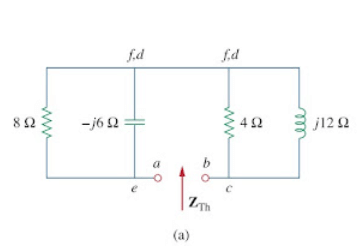Thevenin & Norton for AC Circuits | Network Theory (Electric Circuits) - Electrical Engineering (EE) PDF Download
The frequency-domain version of a Thevenin equivalent circuit is drawn in Figure. where a linear circuit is replaced by a voltage source in series with an impedance.
The Norton equivalent circuit is depicted in Figure. where a linear circuit is replaced by a current source in parallel with an impedance.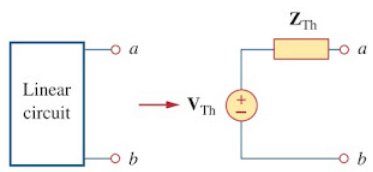 Figure 1. Thevenin equivalent
Figure 1. Thevenin equivalent
 Figure 2. Norton equivalent
Figure 2. Norton equivalent
Keep in mind that the two equivalent circuits are related as just as in source transformation, VTh is the open-circuit voltage while IN is the short circuit current.
VTh = ZNIN, ZTh = Zn
If the circuit has sources operating at different frequencies (will be shown in the example below), the Thevenin or Norton equivalent circuit has to be determined at each frequency.
This leads to entirely different equivalent circuits, one for each frequency, not one equivalent circuit with equivalent sources and equivalent impedances.
We will not cover the ‘step-by-step’ using these methods, make sure you learn it from the previous posts about Thevenin’s Theorem and Norton’s Theorem for dc circuit.
It is not that different from the ac circuit.
Thevenin and Norton Equivalent AC Circuit Examples
For a better understanding let us review the examples below.
1. Obtain the Thevenin equivalent at terminals a-b of the circuit in Figure.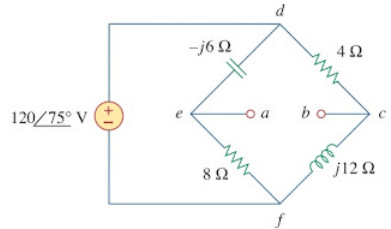
We find ZTh by setting the voltage source to zero. As shown in Figure. the 8 Ω resistance is now in parallel with -j6 reactance, so that their combination gives
Similarly, the 4 Ω resistance is in parallel with the j12 reactance, and their combination gives
Solution for Figure.: (a) finding ZTh, (b) finding VTh
The Thevenin impedance is the series combination of Z1 and Z2; that is,
ZTh = Z1 + Z2 = 6.48 - j2.64Ω
To find VTh, consider the circuit in Figure. Currents I1 and I2 are obtained asApplying KVL around the loop bcdeab in Figure gives
or
2. Find the Thevenin equivalent of the circuit in Figure. as seen from terminals a-b.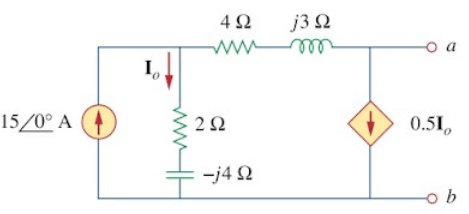
To find VTh, we apply KCL at node 1 in Figure.(6a).
Applying KVL to the loop on the right-hand side in Figure.(6a), we obtain
or
Hence, the Thevenin voltage is
The solution of Figure.(a) finding VTh, (b) finding ZTh
To obtain ZTh, we remove the independent source.
Due to the presence of the dependent current source, we connect a 3 A current source (3 is an arbitrary value chosen for convenience here, a number divisible by the sum of currents leaving the node) to terminals a-b as shown in Figure. At the node, KCL gives
Applying KVL to the outer loop in Figure. givesThe Thevenin impedance is
3. Obtain current Io in Figure.(7) using Norton’s theorem.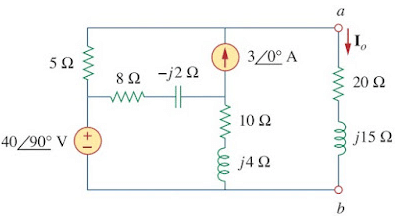
Our first objective is to find the Norton equivalent at terminals a-b. ZN is found in the same way as ZTh.
We set the sources to zero as shown in Figure.(8a). As evident from the figure, the (8 – j2) and (10 + j4) impedances are short-circuited, so that
ZN = 5Ω
To get IN, we short-circuit terminals a-b as in Figure. and apply mesh analysis.
Notice that meshes 2 and 3 form a supermesh because of the current source linking them. For mesh 1,
Solution of the circuit in Figure: (a) finding ZN, (b) finding VN, (c) calculating Io
For the supermesh,
... (3.2)
At node a, due to the current source between meshes 2 and 3,
I3 = I2 + 3 ......(3.3)
Adding Equations.(3.1) and (3.2) gives
From Equation.(3.3),
The Norton current is
Figure.shows the Norton equivalent circuit along with the impedance at terminals a-b. By current division,
|
76 videos|152 docs|62 tests
|



